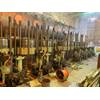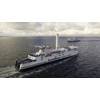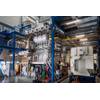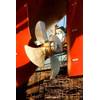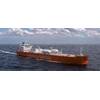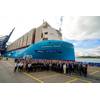Catastrophic Equipment Failures of VFD and HF Systems
Catastrophic Equipment Failures of VFD and HF Systems For Electric Propulsion Systems are Alarming Situation
Standard requirement: Systems need better self-monitoring and protection
Commercial and military users of electric propulsion systems have experienced failures of the variable frequency drive (VFD) and harmonic filter (HF) systems because the system design, including the VFD, did not have adequate self-monitoring and protection.
On a ship, a variable-frequency drive (VFD) can be used to control the speed and direction of rotational motors, such as pumps, propellers and azipod systems.
In some cases, these failures have resulted in catastrophic equipment failures causing arcing, fire and explosions of capacitors.
In September of 2010, the Cunard Carnival cruise ship RMS Queen Mary 2 (QM2) was underway in the Mediterranean when an explosion occurred in the aft main switchboard room resulting from the failure of one of 12 capacitors in a harmonic filter, causing a power outage on the ship and all four electric-drive Rolls-Royce Mermaid podded-propulsion motors to shut down. QM2 has four Wärtsilä 16V46CR marine diesels and two GE LM-2500+ gas turbines for main propulsion.
The U. K. Marine Accident Investigation Branch (MAIB), a branch within the Department for Transport that “examines and investigates all types of marine accidents to or on board UK vessels worldwide, and other vessels in UK territorial waters…. to determine its circumstances and causes, with the aim of improving the safety of life at sea and the avoidance of accidents in the future,” investigated the QM2 incident.
According to the MAIB investigation report of the QM2 incident— which MAIB classified as a “less serious marine casualty”—emergency power came online immediately and the engineers were able to isolate the after switchboard. “The emergency generator started automatically and provided essential supplies to the vessel, and it was quickly established that the explosion had taken place in the aft harmonic filter (HF) room, situated within the aft main switchboard. The aft main switchboard was isolated, main generators were restarted and the ship was able to resume passage.”
The MAIB report determined that “the explosion was triggered by deterioration in the capacitors in the aft HF. Internal arcing between the capacitor plates developed, which vaporised the dielectric medium causing the internal pressure to increase, until it caused the capacitor casing to rupture. Dielectric fluid vapour sprayed out, igniting and creating the likely conditions for an arc-flash to occur between the 11000 volt bus bars that fed power to the aft HF.”
“A current imbalance detection system, which was the only means to warn against capacitor deterioration, was found to be inoperable, and it was evident that it had not worked for several years,” the report said.
Equipment deterioration and insufficient monitoring led to an explosion, arcing and fire aboard a 140,000-ton, 1,130-ft. ship, which normally carries 2,620 passengers and 1,253 crew members.
Although equipment failure due to manufacturing defects is possible, the initial degradation of the capacitor was likely caused by being “subjected to voltages in excess of their design rating or being exposed to frequent voltage transients due to increased number of switching cycles.”
The problem, which concerns oil filled capacitors and other types of capacitors that don't use flammable insulation, is that the mitigation for failure effects of failed capacitors has not been adequate.
Some mitigation strategies include:
- using non-oil filled capacitors
- improving the capacitor health monitoring systems
- employ protection systems in the capacitor banks on detection of a capacitor failure
- If using oil filled capacitors, employing arc fault detection protection and fixed fire extinguishing
- Minimize the use of capacitors through inverter design.
Of further concern was that the protections that were in place—an alarm notification—was overlooked in the confusion created when so many alarms occur almost constantly.
The P1200 propulsion alarm system (PMS) is part of the ship’s integrated automation system (IAS). There was a possible warning of a problem when there was a PMS alarm about 36 minutes before the explosion. Because the IAS has so many alarms—about one every minute—watchstanders can become immune to them.
Granted, electric drive propulsion systems represent a small percentage of the total number of ships over 300 tons.
Of all operational vessels over 100 gross tons, MAIB indicated that just 1.85% of them have high voltage electric propulsion systems, although they are becoming more commonplace. The MAIB report said that 4.10% of vessels being constructed are electrically propelled. “Variable speed motors are becoming commonplace in new ships with electrically-driven propulsion, cargo pumps or other applications, benefiting from this technology.”
Norwegian classification society DNV reported that it has 319 vessels registered which have high voltage electric propulsion, the majority of them using capacitor-based harmonic filters.
There are several classes of warships with electric drive, and some of the newest, most sophisticated ships have integrated propulsion systems, such as the British Type 45 air warfare destroyer and the DDG 1000 guided missile destroyer for the U.S. Navy.
Aware of the cause of the QM2 fire and the findings by MAIB, the Naval Sea Systems Command (NAVSEA) in Washington issued a letter (9830, Ser 05D/219) on May 4, 2012, with the following actions and recommendations:
Action:
a. Remote monitoring of electric networks to achieve advance warning of capacitor deterioration (ex: current imbalance, transient voltage spikes, resonances, excessive harmonic distortion levels and temperature monitoring).
b. Fixed fire extinguishing systems appropriate for fire hazards and electrical voltage in the space be supplied for any space with oil filled capacitors because of the potential for a fire.
c. Warning placards for spaces containing medium and high voltage equipment stating that the space should not be entered while equipment is energized.
d. Fail safe protection systems where failure of the equipment or machinery may lead to serious damage or injury to personnel.
e. Arc Flash analysis and mitigation early in the design process and arc flash hazard level labeling.
Recommendations:
a. The Military Sealift Command (MSC) review their in-service ships, and the U.S. Coast Guard (USCG) review their in-service ships and new designs, for the purpose of assessing the risk of fire due to failure of oil filled capacitors. The mitigation measures of [above] should be given consideration, in advance of any future rule changes.
b. MSC and USCG collaborate with NAVSEA to pursue rule changes to SVR, IEEE and IEC.
c. USCG pursue appropriate changes to SOLAS rules under IMO.
Furthermore, the IEEE standards-development committees are working on solutions to these failures. IEEE Std 1662TM-2008 states: “In the case of a catastrophic fault, power electronics equipment shall protect its surrounding environment and personnel. If the equipment shuts down due to an internal catastrophic fault, the equipment controller shall inhibit a remote or an automatic startup. The automatic shutdown of the equipment shall de-energize its output and shall coordinate isolation from the system.”
Mohammed Islam chairs the Central Coordinating Committee for Developing IEEE-45 Standards, as well as chairing IEEE Std P45.1, “Recommended Practice for Electrical Installations on Shipboard – Detailed Design.” Islam believes that ship design efforts need to increase the system-level integration design activities or require stricter self-monitoring and control for purchased VFD equipment.
“This situation demands urgent undertaking by the authorities having jurisdiction,” he said.
Islam recommends the following corrective actions:
a. Authorities with jurisdiction establish a committee to:
1) Develop a process for on-site investigative action and reporting for all ships with VFD equipment.
2) Develop a process for the VFD suppliers to establish their duties and responsibilities to provide safe equipment to the maritime industry.
3) Develop a process for the ship design agents to define their responsibilities for design and integration of VFD equipment.
b. Review the findings of the committee and develop guidelines for the ship designers, VFD suppliers, and all related equipment suppliers.
c. Circulate an announcement urgently to the commercial and military ship operators to do the following:
1) Advise operators of the findings.
2) Advise operators of necessary immediate corrective action.
3) Develop rules and recommendations for designing stable VFD systems.
4) Develop rules and recommendations for maintenance of VFD systems to allow systems to operate for their intended life and for the safety of operators.
Islam invites interested individuals seeking additional information or to willing to contribute to the efforts to mitigate this issue to contact him at [email protected] or 504-333-5004.
Dr. Yuri Khersonsky is a life senior member of IEEE and was chair of the committee that developed IEEE Std. 1662™-2008, “Guide for the design and application of Power Electronics in Electrical Power Systems on Ships.” According to Khersonsky, the standard states that systems should have a sufficient operational safety margins and protections.
Design requirements
Power electronics equipment should be designed for continuous operation at 110% (as defined in
IEEE Std 1566TM-2005) within the maximum ambient and cooling water or air temperature (if water or air cooled) without reduction of the equipment’s rated performance criteria.
Power electronics equipment should be provided with a minimum overload rating of 150% for 1 min.
Power electronics equipment should be used in preference to electromechanical equipment to supply electric power having characteristics that differ from those of the power furnished by the ship service distribution.
From a power electronics perspective, it is preferable that high resistance grounding (HRG) be used on the source side of all new marine applications on isolated and otherwise ungrounded three-wire, three-phase distribution systems with voltages over 1000 V and aggregated power above 1.5 MW
Power electronics equipment should be selected for the highest operating efficiency that is commensurate with reliability, duty cycle, and requirements of minimum size and weight. Power electronics equipment should have a minimum efficiency of 95% (5% total losses) at rated load condition.
Control systems should be designed such that they do not create negative damping on other systems or equipment. The load input impedances of the power electronic equipment should include effects of filters, switched portions of converters, and resistive portions of the load over the appropriate frequency range. The minimum Nyquist stability margin shall be a 3 dB gain margin and a 30° phase margin at all load levels. The stability margin should not reduce power system efficiency more than 1%.
Protection requirements
Power electronics equipment with controllable converters should be equipped with the capability to manage fault current for system protection and for avoiding shutdowns due to intermittent faults. The converter fault-current-limiting feature should reduce the fault current to the specified limiting level in every instance when the fault happens. The equipment shall automatically shut down before the interface current exceeds a catastrophic level.
In the case of a catastrophic fault, power electronics equipment shall protect its surrounding environment and personnel. If the equipment shuts down due to an internal catastrophic fault, the equipment controller shall inhibit a remote or an automatic startup. The automatic shutdown of the equipment shall de-energize its output and shall coordinate isolation from the system.
Reliability and maintainability requirements
Unless otherwise specified, power electronics equipment should incorporate the following Reliability and maintainability (R&M) provisions:
The PE equipment and all its components should be designed and manufactured for a minimum service life of 20 years. This should include availability of spare parts and appropriately trained field service personnel.
PE equipment should be designed to achieve a mean time between failure (MTBF) of not less than 25 000 h using NAVSEA TE000-AB-GTP-010-1991 for design and derating guidelines.
PE equipment should be designed to achieve a mean time to repair (MTTR) of 1 h or less for any line replaceable unit (LRU). The maximum time to repair should not exceed 3 h at the 95% confidence level. Repair times should include the time required for detection, isolation, disassembly, LRU replacement, reassembly, alignment, verification of repair, setup, and return to operation.
The Author
Captain Ned Lundquist retired from the U.S. Navy in 2000 and continues to be involved with maritime and naval affairs. He is a frequent contributor to Maritime Reporter and Marine Technology Reporter.
(Source: Maritime Reporter & Engineering News, July 2012 - www.marinelink.com)


